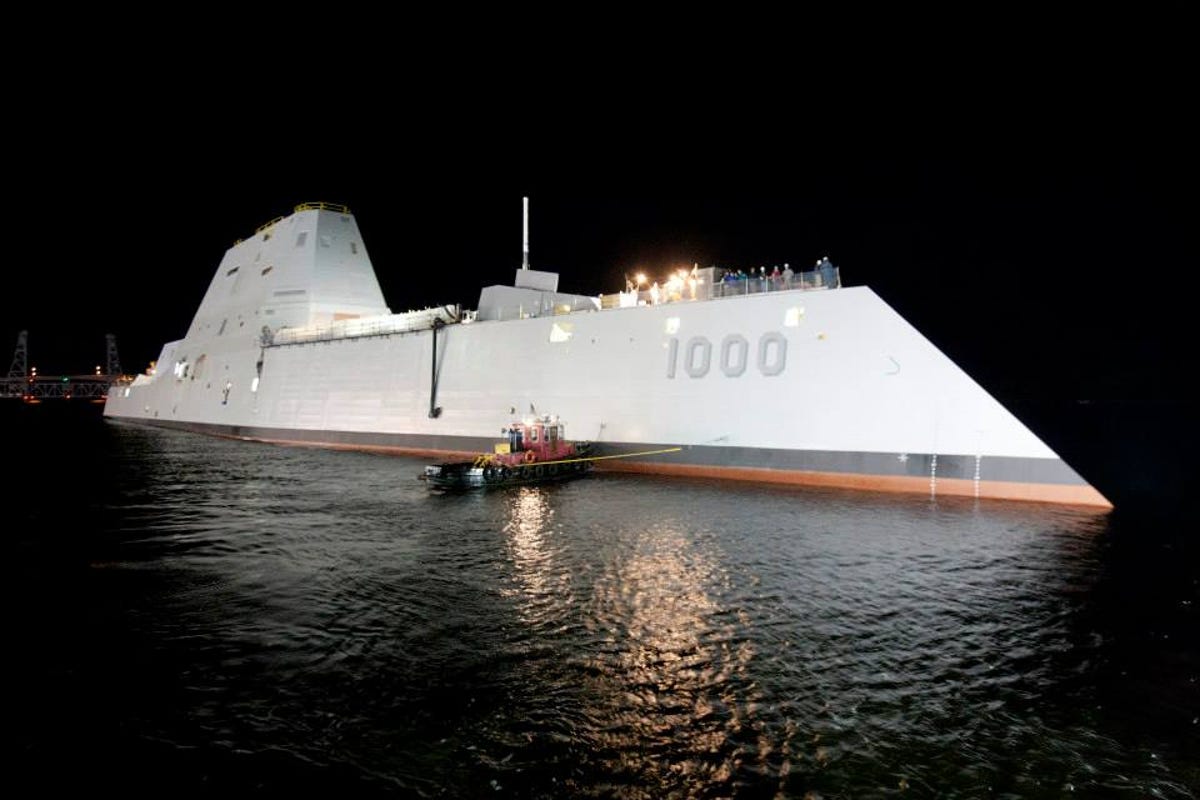Zumwalt: The Navy's massive, high-tech destroyer is here (pictures)
The cutting-edge warship finally enters the water, chockablock with an all-electric integrated power system, an advanced gun system, radar-reflecting angles, and a striking inward-sloping tumblehome hull.

Next-gen Zumwalt-class destroyer
General Dynamics Bath Iron Works launched the first of the Navy’s next-generation Zumwalt-class destroyers on Monday at its Bath, Maine, shipyard.
The 610-foot-long ship is chockablock with new technologies including radar reflecting angles, a striking inward-sloping tumblehome hull, an all-electric integrated power system, and an advanced gun system.
Tumblehome hull
This exterior shot gives a good perspective on the tumblehome design. Meanwhile, on the inside: the cutting-edge operating system aboard the Zumwalt, known as the Total Ship Computing Environment (TSCE), was developed by Raytheon.
The TSCE is the first large-scale implementation of the US Navy's open-architecture strategy. It is designed to bind all Zumwalt on-board systems together and allow for a significant reduction in manning -- with an standard crew size of 130 and an aviation detachment of 28 sailors -- compared to Arleigh Burke-class destroyers.
Raytheon said the systems' open architecture design enables commonality across the US Navy's entire family of ships, which allow for easier updating and systems modifications for years to come.
Ready, aim, fire
The DDG 1000 Zumwalt has a Peripheral Vertical Launching System (PVLS), with each PVLS compartment containing and protecting one MK57 Vertical Launching System.
The cutting-edge computer weapons system also features a couple of 155-millimeter advanced gun systems which can fire rocket-propelled warheads at a range of up to 83 nautical miles. The Navy said the gun system firepower is equivalent to having twelve 155mm howitzers -- giving the ship a three-fold improvement in naval surface fire coverage when compared to current capabilities.
Design features and systems
The Zumwalt-class destroyer represents what the US Navy describes as a next-generation destroyer technology for deployment in land attacks and anti-surface and anti-air missions.
Workers at General Dynamics' Bath Iron Works in Maine will continue working on the ship through the year. The timetable is to deliver the ship to the Navy in late 2014. The first Zumwalt is expected to be sailing the seas and fully operational sometime in 2016, the Navy said.
Autonomic Fire Suppression System
Along with increased offensive capabilities, the Zumwalt's Autonomic Fire Suppression System equips the ship with an automated damage-control system. It uses a network of sensors, cameras, and automated firefighting capabilities offering the Zumwalt fastest response time to threats.
Under construction
The ship began its transition from the land-level construction facility to a floating dry dock on October 25, 2013. The dry dock was flooded, and the shipped was removed from its construction cradle Monday before sailing into the Kennebec River.
Enhanced stealth capabilities
Big ship, low profile
The absence of high-profile masts and rotating antennas, combined with a composite-material deckhouse, means the Zumwalt-class destroyer will be extremely low profile.
Water sleeting along the sides, along with passive cool air induction, also reduce signature thermal emissions, and although it's almost 40 percent larger than a current Arleigh Burke-class destroyer, the radar signature will be more like that of a simple fishing boat than a menacing military machine.

